Pontefract, West Riding of Yorkshire
Up to 1834
Pontefract had a workhouse on Micklegate. After the adjacent Bead (or Bede) House Hospital closed in 1811, this was incorporated into the workhouse.
Knottingley workhouse stood at the west end of Hill Top, where the Arcade now stands.
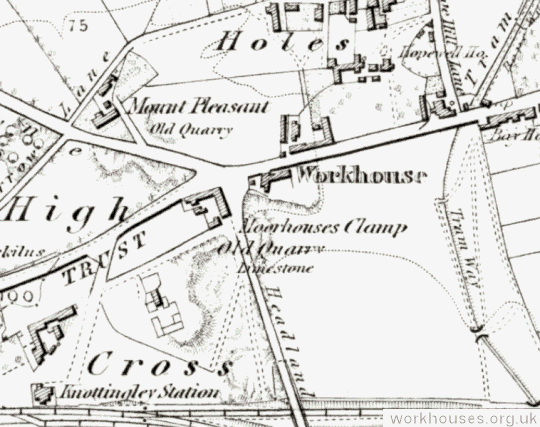
Knottingley workhouse site, 1852.
Other parish poorhouses is the area included ones at Beaghall, Fairburn, Darrington and Snydale. The Fairburn poorhouse stood on what is now Rawfield Lane.
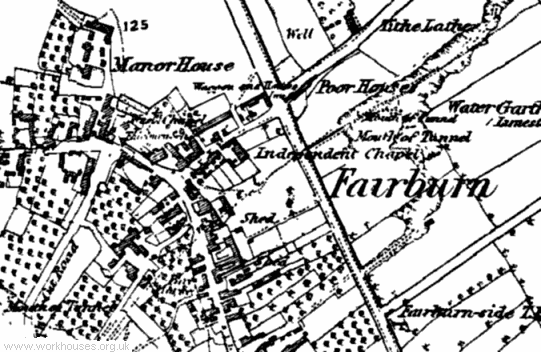
Fairburn poorhouse site, 1852.
Darrington's poorhouse, or rather poorhouses, lay at the west of the village — to the west of what is now Orchard Lane.
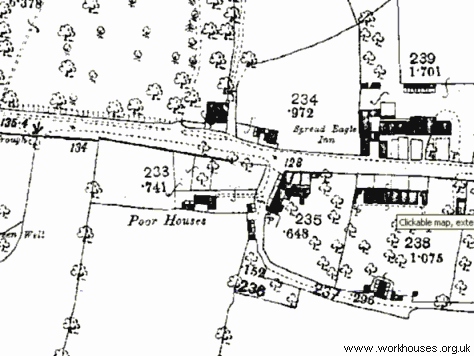
Darrington poorhouse site, 1893.
The Snydale poorhouse was at the west side of Church Lane.
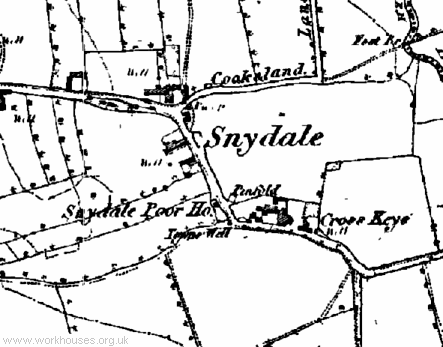
Snydale poorhouse site, 1852.
In 1834, the Royal Commission investigating the poor relief system recorded that:
After 1834
The continued existence of several Gilbert Unions in the West Riding thwarted the Poor Law Commissioners plans to unionize the area and Pontefract continued operating its own town workhouse on Micklegate.
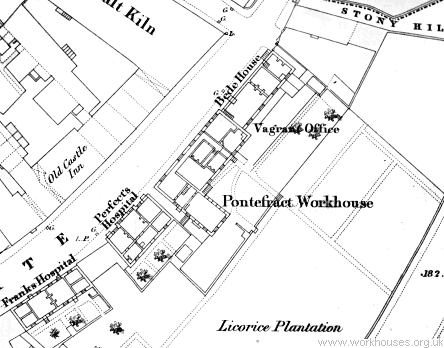
Pontefract Micklegate site, 1849.
Progress was slowly made in the creation of new unions beginning with Hemsworth in 1850. The Pontefract Poor Law Union officially came into being on 15th February 1862 and included some parishes that had previously been members of the Great Preston Gilbert Union. Its initial membership comprised 19 parishes and townships: Balne, Birkin, Byram cum Poole, Cridling Stubbs, Eggborough, Monk Frystone, East Hardwick, Heck, Hensall, Hillam, Kellington, Knottingley, Monkhill, Pontefract, Snydale, Stapleton, Tanshelf, Whitley, and Womersley. Pontefract and Knottingley each had three members on the Board of Guardians, while the remainder had one.
The abolition of all remaining Gilbert Unions in 1869 led to further reorganisation in the area. Pontefract lost some parishes to other unions such as Tadcaster, and in turn gained the parishes of Ackton, Beaghall with Kellingley, Brotherton, Burton Salmon, Carleton, Castleford, Darrington, Fairburn, Featherstone, Ferry Fryston, Glass Houghton, Ledston, Methley, Pontefract Park, Purston Jaglin, Sutton, Water Frystone, and Whitwood.
A Pontefract Union workhouse was erected in 1862-4 at the north of Pontefract on a site bounded by Skinner Lane and Back Northgate. The building was constructed of brick with a three-storey main building. Other buildings on the site included a large infirmary at the north-west of the main block, and a separate block for women and children to the east. The site layout is shown on the 1907 map below.
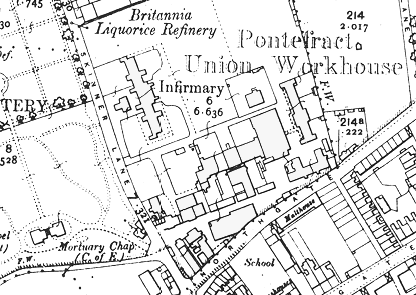
Pontefract workhouse site, 1907.
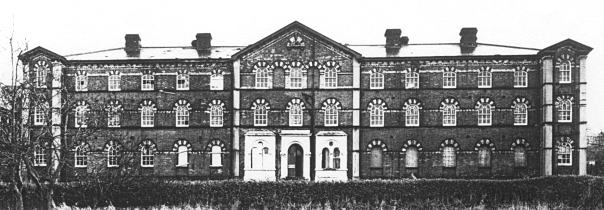
Pontefract workhouse main building from the north, 1980s.
From 1904, to protect them from disadvantage in later life, the birth certificates for those born in the workhouse gave its address as 1 Paradise Gardens, Tanshelf, Pontefract.
Also in 1904, a new administration block was erected at the east ofthe main building.
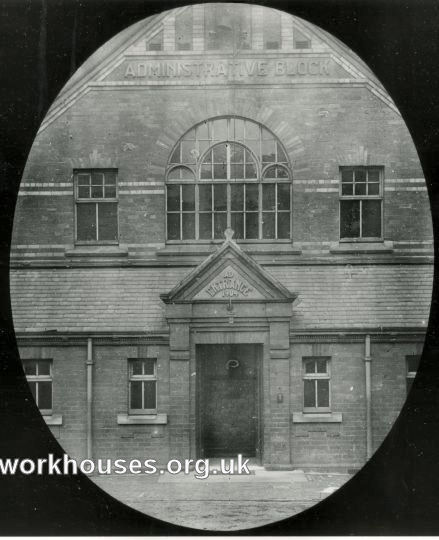
Pontefract workhouse administration block, c.1905.
Able-bodied inmates of the workhouse were expected to perform manual labour. For women this included domestic duties such as cleaning, laundry and kitchen work. Tasks for the men included sawing logs, chopping firewood and breaking stone.
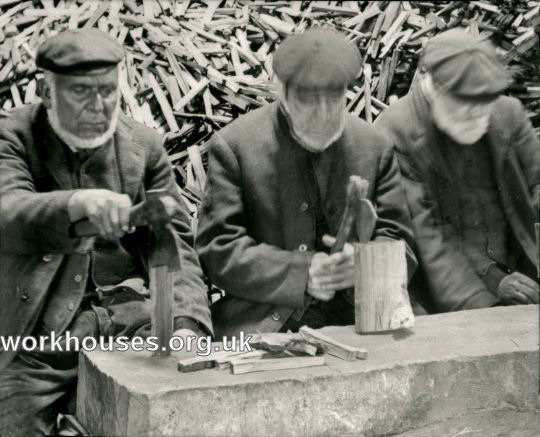
Wood chopping at Pontefract, 1920s.
© Peter Higginbotham.
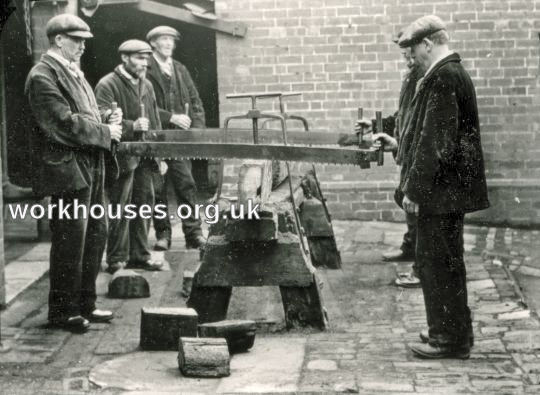
Wood sawing at Pontefract, 1920s.
© Peter Higginbotham.
Vagrants, or 'casuals', could spend up to two nights at the workhouse and carried out stone-breaking in special cells equipped with a grid in the outer wall. Large pieces of stone had ro be broken up into pieces small enough to be passed through the holes to the outside.
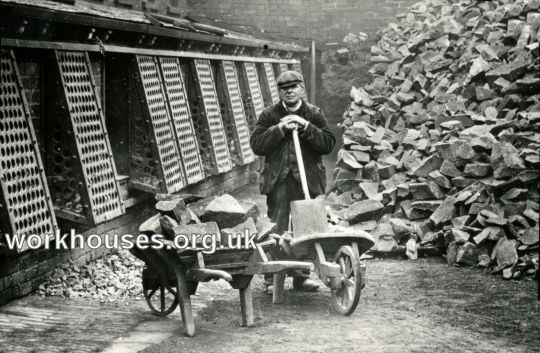
Stone-breaking cells at Pontefract, 1920s.
© Peter Higginbotham.
| View an early 1900s slideshow picture album of the Pontefract workhouse. |
In 1930, the workhouse came under the control of the West Riding County Council. Its layout at this date is shown on the plan below.
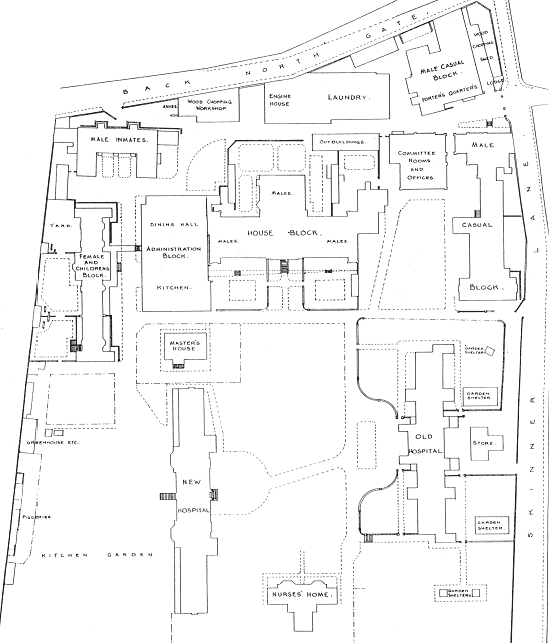
Pontefract site, 1930.
The site became part of the Osgoldcross Guardians' Area and was renamed Headlands Public Assistance Institution, providing care mainly for the elderly. Electricity was installed in 1935. In 1938, it is recorded that the building was used for gas-mask training. In 1948, the institution became part of the National Health Service as Northgate Lodge Hospital, still providing geriatric care. The northern part of the site became the Headlands Hospital. Nothgate Lodge closed in 1971 and some of the buildings were converted to offices for local social services. After the closure of Headlands Hospital, the whole site was redeveloped as housing. The main workhouse building still survives and has been converted to flats.
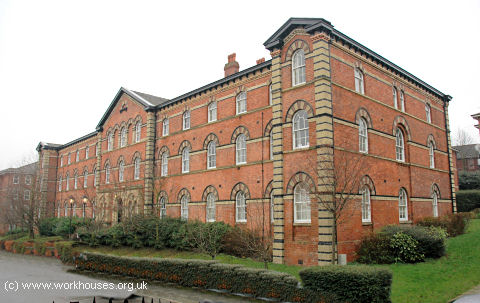
Pontefract workhouse main building from the north-west, 2006.
© Peter Higginbotham.
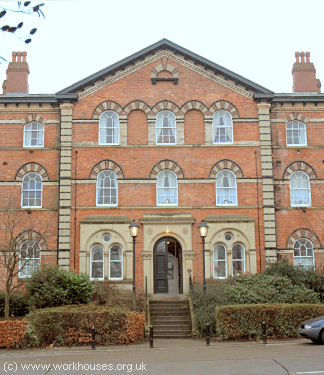
Pontefract workhouse main building entrance from the north, 2006.
© Peter Higginbotham.
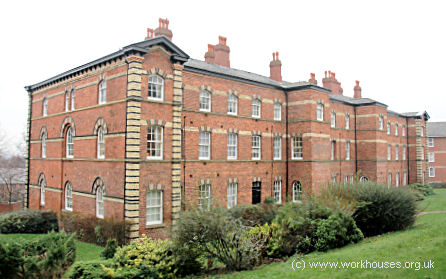
Pontefract workhouse main building from the south-west, 2006.
© Peter Higginbotham.
Cottage Homes
In around 1906, the Pontefract Union erected children's cottage homes at Carleton with an additional home being added in 1912. In total, they could accommodate 120 children. The Carleton homes were located on Moor Lane and comprised two double cottages, and infants' nursery, and an administrative building referred to as 'Top Home' where the matron had her quarters and older children also lived prior to their leaving the homes.
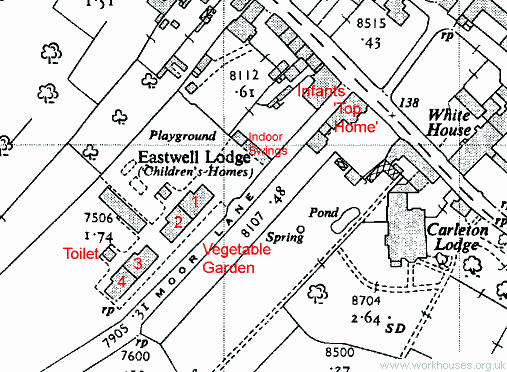
Carleton Cottage Homes site, 1953.
Homes 1 and 3 housed boys, while homes 2 and 4 housed girls. In each home, up to sixteen children lived under the supervision of a house mother and a head girl.
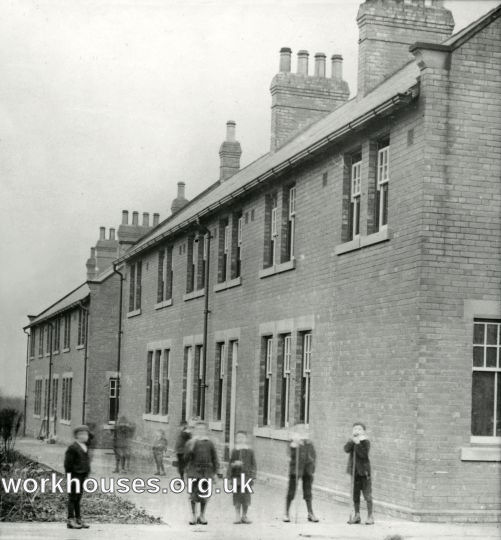
Carleton Cottage Homes from the north-east, early 1900s.
© Peter Higginbotham.
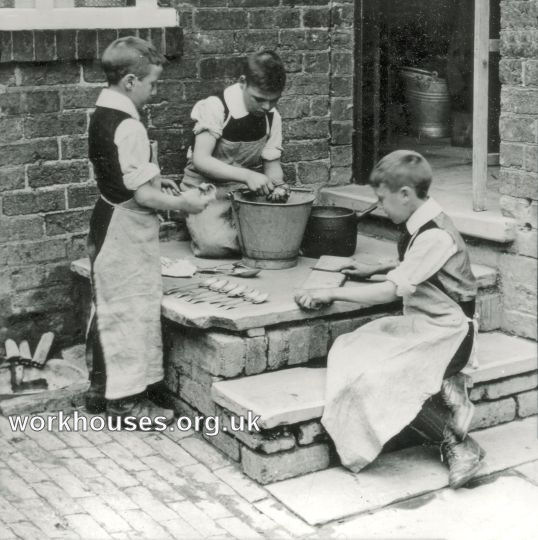
Boys doing chores at Carleton Cottage Homes, early 1900s.
© Peter Higginbotham.
In 1906, following the Guardians' refusal to contribute to the cost of an extension at the local council-run school, the children from the cottage homes were barred from attending the school. The Guardians eventually agreed, very reluctantly, to make the payment requested by the council.
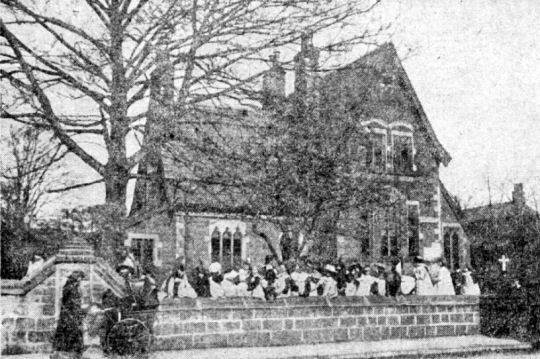
Lock-out of cottage homes children at Carleton school, 1906.
After 1930, the homes were taken over by the district council and became known as Eastwell Lodge.
| View an early 1900s slideshow picture album of the Carleton Cottage Homes. |
Thomas Pickett
From 1923 to around 1932, the Master of the Pontefract workhouse was Thomas William Pickett. Thomas's grandson, Edwin Pickett, has researched the life of his grandfather and has kindly allowed the results of his investigations to be included below.
Having been born in a poor law institution in Kingsclere, Hampshire, and then resided in a similar place in Stratford-on-Avon due to his father's occupation, it seems that 'poor law' was in TW's blood. He followed in his father's footsteps and worked in a poor law institution in Towcester, Northants in 1915 at the age of 23.
He had married Mabel Florence Brown in Lichfied, Staffordshire in 1913. Mabel Florence was a qualified nurse and this enabled the couple to obtain joint posts. In 1914 their son John Henry was born. Shortly after arriving in Towcester John Henry died, having contracted meningitis and Eleanor Margaret was born. Thomas Victor was also born in Towcester but both John Charles and Frederick William were born in the inappropriately named 'Paradise Gardens' in Pontefract. Thomas was appointed Assistant Master of the workhouse, and Mabel was a general assistant. In the Guardians' minutes for October 1923 He is referred to for the first time as Master of the workhouse and Mabel as Deputy Matron.
The men's block was erected in 1867 and was referred to as the 'Bastille'. Indeed, one master had been so severe that some of the inmates ran away. The place was greatly enlarged with the addition of a laundry block (1897), a gatehouse and offices (1898) and an administration and women's block (1904). The workhouse also had its own power plant and attendant engineer (Fred Keighley) and was a very large place.
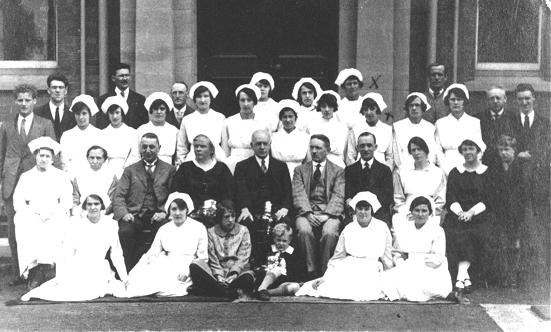
Workhouse staff at Pontefract at Pontefract, 1920s
courtesy of Edwin Pickett
In the early 1920s, a large infirmary building was also erected. In the observation block were padded cells for containing inmates who required transferring to Wakefield Asylum.
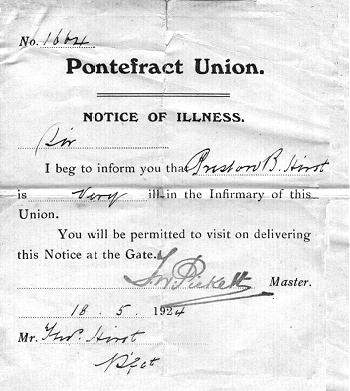
Illness notice at Pontefract, 1920s
courtesy of Edwin Pickett
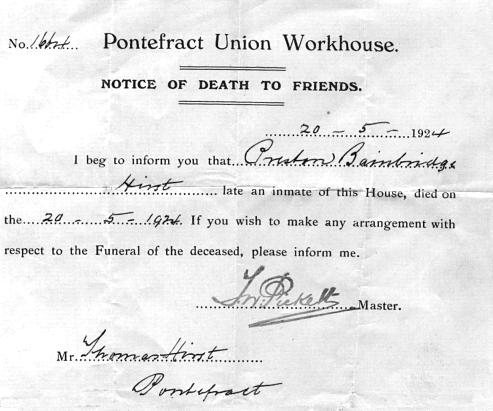
Death notice at Pontefract, 1920s
courtesy of Edwin Pickett
At the workhouse various forms of hard labour were organised to help pay for the upkeep of the inmates and also act as deterrent in the unlikely event that anyone saw life in the workhouse as an easy option. The type of work expected at Pontefract included sawing logs, chopping firewood or breaking stone.
Although not intended as a soft option and a system that has been much denigrated in later years, evidence shows that there was a softer side to such institutions. A copy of an expenses sheet from minutes issued during 1926 shows several entries related to 'Toys', 'Christmas Extras' and 'Gramophone repairs'. Similarly, an item found amongst a box of old papers, mainly printers proofs, shows a copy of an order, dated 27/3/24, for the licorice factory to supply 2,500 Woodbine Cigarettes (may have been sweets), 4000 Sherbert Suckers and 2000 Gobstoppers.
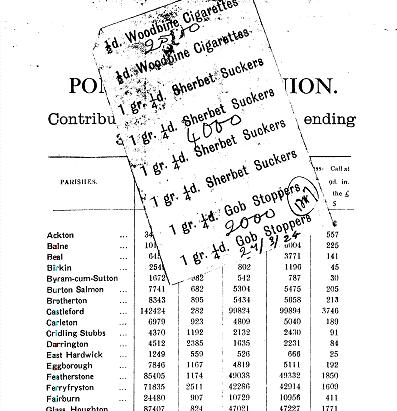
Sweets order form from Pontefract, 1920s
courtesy of Edwin Pickett
It is also clear that being on the Board of Guardians was not always an onerous task as the copy of a Farewell Dinner menu will show. It must have been a 'grand do' as the order scribbled on the front shows that 100 copies were required. It is not clear who was being bidden farewell, but Thomas was a responder to the toast to 'the officials and staff'.
Staff
Inmates
Records
Note: many repositories impose a closure period of up to 100 years for records identifying individuals. Before travelling a long distance, always check that the records you want to consult will be available.
- West Yorkshire Archive Service (Wakefield Office), West Yorkshire History Centre, 127 Kirkgate, Wakefield WF1 1JG. Very few records survive — holdings include: Guardians' Minutes (1907-30); Ledger (1926-30).
Bibliography
Links
- A website devoted to the Eastwell Lodge cottage homes.
- Stan Briggs' memories of Carleton Cottage Homes
- Knottingley Workhouse by Terry Spencer (archived).
- Ripon Workhouse Museum and Garden, Sharow View, Allhallowgate, Ripon HG4 1LE.
Acknowledgment
- Thanks to Edwin Pickett his contribution to this page.
Unless otherwise indicated, this page () is copyright Peter Higginbotham. Contents may not be reproduced without permission.


